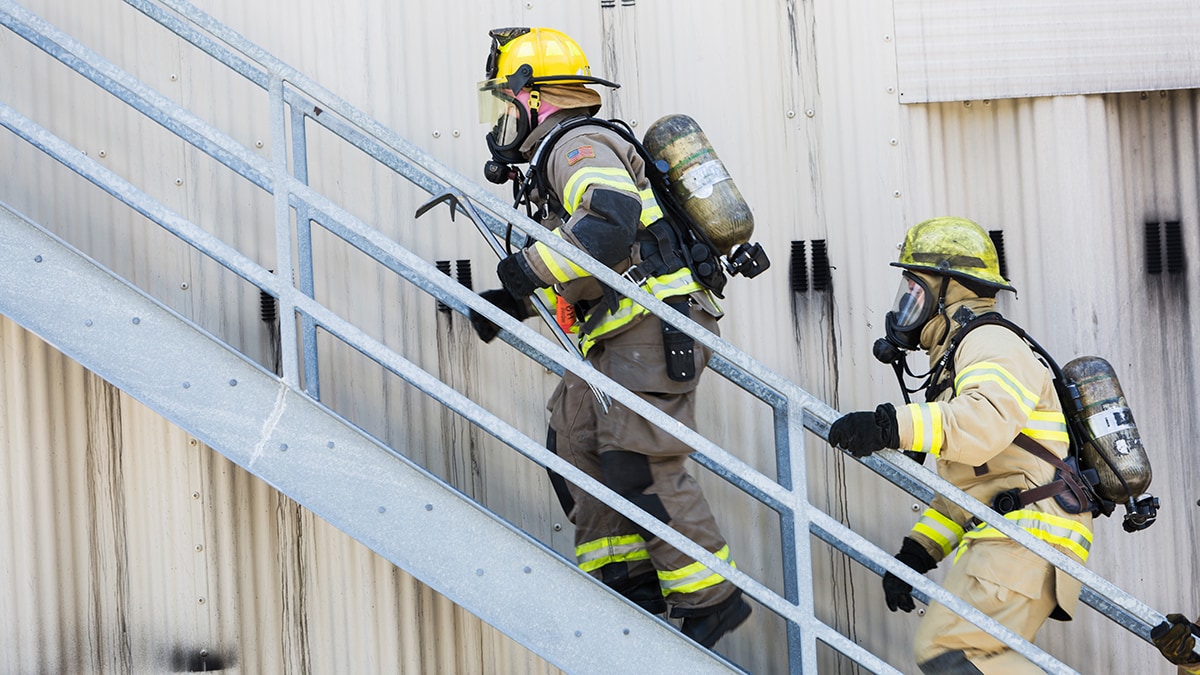At a glance
Key accomplishments from the Emergency Responder Training Program and the Miner Safety and Health Training Program—Western United States in FY 2020. This includes more than 1200 emergency responders trained and new training options for miners.

Introduction
NIOSH funds specialty training programs for first responders, commercial fishermen, and miners. Selected highlights from the Emergency Responder Training Program are provided below. New training options from Miner Safety and Health Training Program—Western United States are also featured.
You can also find this information and more in NIOSH Extramural Research and Training Program: Annual Report of Fiscal Year 2020.
Emergency Responder Training Program
Through the International Association of Fire Fighters (IAFF), NIOSH supports a nationwide program to enhance the capabilities of firefighters engaged in emergency response through training. The training is site- and trade-specific and aims to reduce on-the-job injuries, illnesses, and fatalities related to emergency response.
In FY 2020, IAFF delivered 63 classes to 1,231 students, totaling 21,608 contact hours.
Table. Emergency responder training classes, FY 2020
| Class Title | Class Length |
Total Classes |
Total Students |
Total Contact Hours |
|---|---|---|---|---|
| Confined Space Operations | 24 hours | 3 | 57 | 1,368 |
| Emergency Response to Terrorism: Operations | 8 hours | 13 | 266 | 2,128 |
| First Responder Operations | 24 hours | 34 | 678 | 16,272 |
| Illicit Drug Labs | 8 hours | 13 | 230 | 1,840 |
Miner Safety and Health Training Program
For FY 2020, NIOSH funded two programs in the Western United States: Colorado School of Mines and University of Arizona. This training provides a joint approach to reducing occupational illnesses, injuries, and fatalities to miners and other workers in mining operations.
New Online Courses for Professionals in Mining Safety and Health
The Colorado School of Mines (CSM) offers a broad Professional Development Curriculum that aims to increase trainers' and safety and health professionals' capacity to train mining workers. In FY 2020, CSM created four online courses under the Professional Development Curriculum and offers them on the CSM website. These classes are called:
- Hazardous Particulates
- Safety Management Systems [Part 1 and 2]
- Mine Safety and Health Administration (MSHA) 101 [Part 1 and 2]
- Sleep: The Most Important Component of Safe Behavior
CSM also held other training activities that included some of these course topics, such as two presentations at the 15th Annual Mine Safety & Health Conference in October 2019, in Reno, Nevada. More than 90 people attended the two presentations: "Sleep: The Most Important Component of Safe Behavior" and "Energy, Mining, and Construction Industry Safety (EMCIS) Training: Fun—Not Funny." CSM staff offered "EMCIS Training: Fun—Not Funny" and another presentation, "Your Brain on Stress and Fatigue," to nearly 50 members of the Society for Mining, Metallurgy & Exploration via a webinar. The CSM program reports many conference and webinar attendees requested slides following the events.
Details: Online Training Modules & Presentations
New Gaming Software Features Enhance Training and Evaluation of Performance
The University of Arizona added a new feature to its computer-based serious gaming software such as "Harry's Hard Choices" and "Harry's Hazardous Day" during FY 2020. This software is used to provide engaging training in miner safety and health through games that lead to increased knowledge transfer. The new feature is a series of game mechanics or computerized rules that guide trainees' actions and tasks they are given while using the game, along with game advancement strategies. These mechanics provide a competency-based evaluation or assessment of trainees' performance during the game, using this assessment to improve the training.
The gaming software is based on the university's Mine Health and Safety Competency Model—a five-tiered approach to occupational safety. The mechanics assess trainees' performance on gaming tasks, providing measures in the areas of (1) skills and abilities, (2) derived attributes based on personality assessments, (3) core attributes based on behavioral tendencies and talents, and (4) class or knowledge of certain jobs or professions. University staff created these mechanics using methodology proven successful in the genre of role-playing games, which includes the university's serious games that train workers through avatars in simulated scenarios. Through this new feature, trainees' choices and behaviors in the game determine their avatars' assigned knowledge, skills, abilities, and other attributes, along with specific tasks they are asked to complete, and guide the feedback, rewards and penalties received during the game.
Details: Harry's Hazardous Day Game Mechanics
